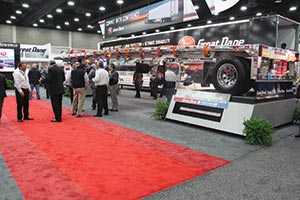New Trailer Orders Slide 30% in February as Manufacturers Tackle Massive Backlog

This story appears in the April 6 print edition of Transport Topics.
Trailer orders fell 30% in February to 20,700 units from the same time a year ago, ACT Research Co. reported, although analysts attributed the decline to a load of backorders late last year.
“We’ve had a really good order season, but the timing is just changing,” said Frank Maly, ACT’s director of commercial vehicle transportation analysis and research. “Large fleets came to the market early, resulting in a front-loaded order season.”
February’s total was 31% below January’s 29,853, but Maly said backlogs remain high and order boards appear to have begun normal seasonal declines.
“The decline in net orders sequentially and year-over-year is due to the tough comparison resulting from that early action — not a sign of weakness in the current market,” he added.
Last year was the highest ever for trailer orders, which hit a monthly record 47,810 in October, followed by 43,832 in December.
Continued “solid freight volumes combined with fleets adding capacity as well as replacing tired equipment are major positives,” he said.
Another group, FTR, reported a similar decline, to 20,400 orders in February, said Don Ake, FTR’s vice president of commercial vehicles.
“Even though backlogs have fallen off, they are up 61% year-over-year, so production should remain strong at least through the third quarter,” he said.
Maly said the typical order cycle is a strong six months — October through March — followed by a six-month build period to fill orders.
“Large fleets’ order cycles are a little earlier than their smaller to medium competitors. Not only did they come in early, they came in with gusto,” he told Transport Topics.
Dry-van orders were down 50% year-over-year, while reefers were up 53% and flatbeds fell slightly.
The overall backlog slipped slightly from January’s recent high of 187,000 and was about 75,000 units, or 70%, higher than a year ago. Dry-van orders slipped more than 50% year-over-year to below 10,000.
“Some manufacturers . . . are essentially sold out for dry vans for 2015,” said Michael Baudendistel, an analyst with Stifel, Nicolaus & Co. “With the backlogs at such historically high levels . . . it’s probably not a reflection of market weakness. It’s just the backlogs are so long, there’s just not a lot of available build slots for 2015.”
Wabash National Corp. declined to comment, citing its upcoming earnings report. It recently completed a revised $192.8 million credit deal.
Chris Hammond, executive vice president of sales for Great Dane Trailers, said business is strong.
While Great Dane “has seen the order slowdown recently . . . it is offset by customers talking about and planning for 2016,” Hammond said.
Great Dane is “filled for vans and reefers, but [we] still have some third- and fourth-quarter flatbed production available,” he said.
David Giesen, vice president of marketing for Stoughton Trailers, said: “The industry came back down to the normal range for February dry-van numbers.”
But for Stoughton, he said, February’s new orders were stronger than normal.
Utility Trailer’s February orders “followed a very typical pattern for this time of year,” said Larry Roland, the company’s marketing director.
Glenn Harney, chief sales officer at Hyundai Translead, said that “all factories are full for dry vans for 2015” and that Hyundai received some 2016 orders it did not yet report.

